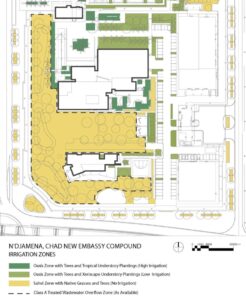Practical Application
Menu
Practical Application
- Review the no- and low-cost water conservation measures identified during the water audit, and implement any no- or low-cost items.
- Implement irrigation system strategies to reduce irrigation waste, such as repairs, controls, scheduling, zoning, or system replacements.
- Ensure that landscape professionals working on-site are knowledgeable about local plants and soil conditions.
- Consider non-potable water reuse strategies for irrigation water, such as rain barrels, where appropriate.
- Install an irrigation meter or meters to track water consumption in order to determine the success of implemented strategies. Add submeters to systems where appropriate.
- Track irrigation water use.
Figure 7: Irrigation zoning can be used to drive plant selection to save water


